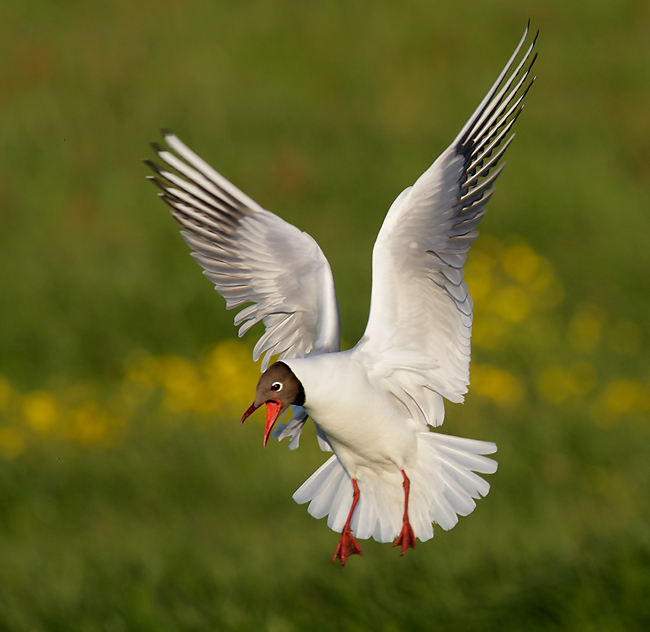
BIRDS AS ART BULLETIN #235
July 4, 2007
Visit: www.birdsasart.com
CANON EOS-1D MARK III REPORT & COMMENTS ON REPORTED AUTOFOCUS ISSUES
ICELAND TRIP REPORT
MARK II USER’S GUIDE
BreezeBrowser Pro 1.7 AVAILABLE
APTATS-1
NYC CITY SEMINAR NEWS
ASSORTED BAA KUDOS
IPT UPDATES
Contact us by phone at 863-692-0906 (Eastern Time Zone) or by e-mail at birdsasart@att.net or birdsasart@verizon.net. The att e-mail address is best from overseas.
We gladly accept credit card orders by phone 8am till 9pm Eastern Time (8 am till 3pm Fridays).
You can use the Paypal links on the web site to order anything. Just type in the item(s) and the amount. If using your own Paypal account, please send to either of the e-mail addresses above.
Note: maximize this e-mail for best formatting.
Photographic theme: flight images from Iceland. All created with the Canon EOS 1D MII.
Important Request: if responding to this e-mail, please take the time to delete all images and all irrelevant text.

Black-headed Gull, Iceland
Image Copyright 2007: Arthur Morris/BIRDS AS ART
Canon 500mm f/4L IS lens with the 1.4X II TC and the EOS-1D Mark III. ISO 400. Evaluative metering -1/3 stop: 1/1000 sec. at f/7.1 in Manual mode.
Once I developed the “frame, acquire, and fire” technique I began making some great flight images. The out-of-focus flowers in the background here are a plus.
CANON EOS 1D MARK III REPORT & COMMENTS ON REPORTED AUTOFOCUS ISSUES
As many of you know, there has been an internet firestorm raging with regards to the Mark III's AF system. I used my new MIII almost exclusively on my recent trip and was pretty much thrilled with it. See the images in this Bulletin and the details below.
Before I begin it is necessary to comment on autofocus in general and on Canon AF systems as well.
When manual focus was the only option, I made about 3 sharp images of birds in flight in twelve years out of trying. I probably took more than 10,000 images of flying birds to get those three sharp ones. When I purchased my first Canon A2 body (as a result of attending a George Lepp seminar in Tampa, FL) I was understandably thrilled with the results. On average I would get ten or so sharp photographs on each roll of film. (Yikes; I cringe when I simply type the word!) I created "Blizzard in Blue" with the A2 body and a tripod-mounted 400mm f/5.6 lens at Bosque right after Elaine's death in 1994. As that image was honored in the BBC Wildlife Photographer of the Year Competition, that camera will always have a fond place in my heart.
Next on the scene was the EOS 1N with its five-across sensors. Initial AF acquisition was faster than with the A2 series bodies. You were advised to "start AF with the central sensor." After you did that, the system would pass the subject off to one of the outside sensors. That set-up worked fairly well. Next in the AF line was the EOS 3 with the first 45 point AF system. After activating all of the focusing points (I dubbed it the "ring of fire" because only the outside sensors were illuminated) you were again advised to "start AF with the central sensor." The first time that I tried 45 point I had a crow right in the middle of the array (against a clear blue sky on a sunny day), and depressed the shutter button halfway; the camera never even saw the subject... I was less than enamored but soon learned to acquire focus with the bird placed somewhere on the edge of the illuminated sensors. In my evaluation I advised Canon that the 45 point AF system was not as central-sensor-dominant as the 1N had been.
It is my understanding that the 45-point AF systems in the EOS-1D, the EOS-1Ds, the EOS-1D Mark II, the EOS-1Ds Mark II, and the EOS-1D Mark IIN were all fairly similar to the system in the EOS 3. Over the years I have developed a love-hate relationship with 45 point AF. At times I have used it exclusively for flight photography with good results; it worked especially well at times with birds flying erratically. Oftentimes, when the system appeared to be tracking accurately, the resulting images were not in sharp focus.
One of my biggest frustrations with 45 point AF for flight (and this seems to apply to the new 45-point system in the Mark III) is that images or birds that are mis-framed (and on the edge of the array) are often razor sharp while images of the same bird (in the same sequence) in the center or the frame are often not sharply focused. 45-point AF, however, was (and is) was ideal for creating pleasing compositions in a wide variety of situations (most of which are covered in ABP II/on CD only). You need to know when to use 45-point and when not to use it... In most flight photography situations we advise folks to activate only the central sensor.
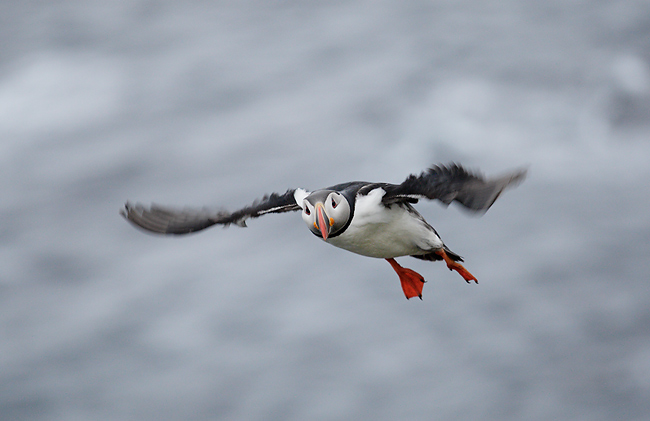
Atlantic Puffin, Iceland
Image Copyright 2007: Arthur Morris/BIRDS AS ART
Canon 70-200mm f/4L IS lens (handheld at 200mm) with the EOS-1D Mark III. ISO 1600. Evaluative metering +1 stop: 1/50 sec. at f/4 in Manual mode.
As we had very few chances with puffins in flight I was more than pleased with my 50% sharp-on-the-eye success rate. Two out of four ain’t bad…
…..
Now let's take a look at the realities of flight photography as I see them. First of all, I do not consider myself a very good flight photographer. I have long been in awe of the images of flying birds produced by the likes of Chas Glatzer and all of the posse members: Robert O'Toole, Robert Amoruso, Alfred Forns, Fabiola Del Alcazar, and Jim Neiger. And James Shadle is not bad either… After viewing their consistently sharp images I often have asked, "What camera were you using; what lens?" They were--of course—usually (except for Mr. Shadle who is a Nikon-user) using the same cameras and lenses that I had been using. Can you say "operator error." In any case, the reality is that even the very best (most highly skilled) flight photographers rarely produce more than 30% razor-sharp-on-the-eye images, and, depending on both the situation and your definition of razor sharp, 10-20% (or even less than 10%) might be more realistic. (Do realize that of every 100 sharply focused flight images only two or three will—because of the bird’s posture and the wing and head positions—qualify as outstanding images…)
There were many times that I was sure that I had the central sensor right on the bird's eye and that the system was tracking perfectly, but the resulting image was well out of focus. How could this be? First and foremost, the skill of the photographer pays a huge role in the accuracy of AF tracking (and I will be the first to admit that I am not very skilled in this area and that what skills I might once have had have been diminishing with age. I recently celebrated my 61st birthday in Iceland.) Can you consistently keep the central sensor on the bird's eye? How adept are you at keeping the subject framed properly. Can you pan to precisely match the bird's speed? When hand-holding, how smoothly can you pan? All of these factors (and more) determine your percentage of razor-sharp-on-the-eye images (and your percentage of acceptably sharp images as well).
Second, most photographers do not realize that AF systems need both light and contrast to see. When you add a teleconverter to the mix, you are stealing light from the AF system; initial focus acquisition and focus tracking accuracy may be compromised. If you have the central sensor on the breast of a Snow Goose or the neck of a raven, there may be--depending on the lighting conditions--little or no contrast; again, initial focus acquisition and focus tracking accuracy may be compromised. Many of the times that I (or we) think that the sensor is squarely on an incoming bird's face it turns out (after examining the active focus point in Breezebrowser) that the sensor was actually on the bird's breast. As a result, the eye is unsharp (even though the AF system performed perfectly...) Add to the mix that birds often fly erratically both with regards to direction and to speed, and it is easy to see why we attain such a low percentage of razor-sharp-on-the-eye images. With AF I have--over the years--been able to produce hundreds of sharp, outstanding images of birds in flight and in action, images that I could never have even dreamed of creating with manual focus equipment.
OK. Let's try to answer the question: can the Mark III be used to create consistently sharp images? Here is my MIII story. The very first chance that I had to make lots of flight images was with some Arctic Terns early on in the Iceland. The light was low and I used the settings that I thought best at the time. Central sensor only. C.Fn. III-2: Slow. C.Fn. III-3: 2. C.Fn. III-4: 1. C.Fn. III-5: 1. C.Fn. III-8: 0. And C.Fn. IV-13: 1. I used the focus and blast 'em technique. While in AI Servo AF I put the sensor on the bird's head or face as best I could and fired away. I think that I made one or two marginally sharp images out of about 100. It was very disappointing at best... The next chance that we had with the terns there was just a bit more light. I changed to C.Fn. III-3: 0 and the results were much better but still nothing to write home about.
Our next flight photography opportunities were with some Great Skuas and I made some very nice flight images including one of an oncoming bird. That was encouraging as I almost never made sharp images of birds flying directly towards me.. I wished that I had brought the 70-200 f/4 instead of the 400 f/5.6 as many of the birds were so close that I clipped a wing or two off many of the birds. I did however, make many sharp images and credited the improvement mostly to the blue skies. A few days later we found an Arctic Tern colony near a gas station and after a while we realized that the Black-headed Gulls that were circling overhead fighting with the terns were actually nesting right along side of them. The weather was cloudy-bright with some sun mixed in and there were lots of flight opps. That afternoon was the beginning of my MIII epiphany. Though we had only limited internet access I received many e-mails with links to the various sites that stated that there were serious issues with the MIIIs AF system and I was determined to make some sharp images. The traditional AF strategy of tracking the bird as it approached was simply not working. With many of the birds flying below the horizon I was not sure whether this was due to problems with the Mark III’s AF system or my inability to keep the central sensor on the bird’s face, but I suspect more the latter than the former.
In any case, I came up with a new strategy. Working with the tripod-mounted 500mm lens, I pre-refocused manually as a subject entered the zone, the spot where it filled a good part of the frame and the light angle was relatively pleasing. I did not press the shutter button as the bird approached, I just continued to focus manually so as to keep the bird fairly sharp in the viewfinder; I was not at all concerned with focusing accurately, just with focusing enough so that the system could see the bird. Then, just as the magic moment arrived, I would depress the shutter button halfway to achieve focus and, almost in the same motion, depress the shutter button fully and make an image or two (or three if I was able to keep the central sensor on the bird). Voila. This new strategy (let’s call it the “frame, acquire, and fire” technique) increased my percentage of either very sharp or acceptably sharp images dramatically. I did get some two and three frame sequences in which each of the images was at least acceptably sharp.
With a bit of practice under my belt, the new technique proved deadly as I worked the edge of a Black-headed Gull colony in a marsh near a fresh water pond. And best of all, this new technique was extremely effective with birds flying below the horizon. In all my years of photographing birds I have rarely been able to make sharp flight images of birds in flight against backgrounds other than sky. In fact, I made several of my all-time sharpest flight images with the MIII.
Posse members Alfred Forns and Fabiola Del Alcazar (http://www.avianscapes.com/) each got their MIIIs a few weeks ago. Alfred has been doing well with the AF system but Fabs has not, and Fabs is a superb flight photographer. After they switched cameras, Al had trouble with the AF system while Fabs did better but still felt that AF tracking and accuracy was not as good as with the EOS 1D Mark IIN. And perhaps there are real problems with AI Servo AF tracking…
I spoke to Alfred by phone on July 3. He is in Newfoundland with Fabs and Chas Glatzer, each with a MIII. They all agree that in the fog and in low light, in shade, and in cloudy conditions that the camera tracks like a dream even against backgrounds other than sky, i.e., water or cliffs. In addition, they all agree that when the sun is out they are simply unable to track anything flying against the ocean background (that with the sun behind them...) As mentioned previously, each is a superb flight photographer.
Internet reports from respected and serious folks (Rob Galbraith: http://www.robgalbraith.com/bins/content_page.asp?cid=7-8740-9006) report a variety of concerns. Interesting are reports that the focus on static subjects shifts while in AI Servo AF. This would seem possible only if the system had little contrast to work with (and would be expected from previous generation camera bodies). Neither my field experience nor a series of focus chart tests could confirm these findings. Perhaps there are some bad Mark IIIs out there...
Internet reports of MIIIs losing focus while in One-Shot AF with the central sensor on the subject are obviously fueled by internet hysteria (or the photographer’s index finger slipping off the shutter button without their realizing it…)
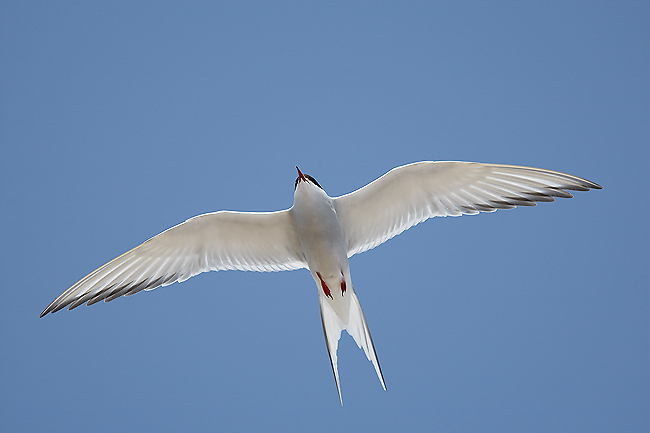
Arctic Tern, Iceland
Image Copyright 2007: Arthur Morris/BIRDS AS ART
Canon 400mm f/5.6L lens (handheld) with the EOS-1D Mark III. ISO 200. Evaluative metering +1/3 stop: 1/1000 sec. at f/5.6 in Manual mode. Manual Flash with Better Beamer at 1:1.
The MIII with the 400 5.6 proved a very effective flight photography combination. To learn when and how to use your flash in Manual Mode, check out “Flash Simplified” in “The Art of Bird Photography II” (on CD only): http://www.birdsasart.com/ABPII.htm
…..
On the flight to Iceland I figured that I would be using my new Mark III about half the time and using my beloved 1Ds Mark II about half the time. I did use the 1Ds Mark II for some scenics early on, and did use it to make some head portraits of puffins near the end of the trip, but I fell so in love with my MIII that I wound up using it for well more than 95% of my bird images. What's the big deal? For starters, the Mark III is so fast that it has completely changed the way that I approach bird photography.
The many who have photographed along side me on IPTs or who have heard me speak over the years know that I have always been pretty much of a one-frame-at-a-time guy. This especially so when creating images of birds in flight or in action. I would anticipate the peak of the action or the best pose, and depress the shutter button just once (or perhaps twice). Many times when I am with a group of photographers creating flight images, a bird will fly by and bam, bam, bam, bam, bam, bam, bam, bam, bam, bam the shutters will fire non-stop. Except for mine… (Sometimes folks keep firing long after the bird has left the zone; either they are trying to impress someone or they like hitting the delete key...) When the smoke clears, I check out the single image that I created. Many times I would not trade my single images for anyone else's best image from a long series...
With the Mark III it is difficult, almost impossible, to make one image at a time when working in High Speed drive (as you should be). With flight photography in Iceland, especially once I had figured things out near the end of the trip, I would make two or three images once the bird entered the zone.
The fast frame rate has affected the way I make portraits more than it has affected the way that I create images of birds in flight or in action. When creating portraits of static subjects with my 1Ds I would usually make a single image (or rarely two) once a subject gave up the proper head angle. With the Mark III I find myself creating 3-5 (or sometimes more) images in similar situations; in most cases a single image is usually—for a variety of reasons—clearly best.
What else is so great about the MIII? The dust removal system is so good as to be barely believable. I two weeks of using my MIII every day in some harsh, windy conditions, I had to clean my sensor just once. With Sensorscope and Lens Pen in hand, the job took about 30 seconds. The new, lightweight battery recharges very quickly and seems to last forever. The LCD screen is huge and bright. While I still find it difficult to judge sharpness on the LCD with the magnifier, it is much easier to note the effect of flash. The quality and color of the images are superb. The MIII handles blacks and dark tones better than any camera I have ever owned; several folks who have seen the optimized Iceland TIFFs commented instantly as to the detail in the darker tones. Noise control on the MIII blows away noise control on all other digital cameras. The Nikon folks on the trip could not believe the lack of noise in the ISO 1600 images that I showed them. The MIII writes faster to the card and, as a result, viewing the histogram is lightening fast. Lastly, the AF micro-adjustment is science-fiction-like. I was stunned to find that my primary 500mm lens required a +19 adjustment.
Like many, I have been very satisfied overall with the Mark III’s AF system and totally thrilled with the camera overall. Several of the folks who have been commenting negatively on the MIII’s AF system have stated flatly that C.Fn. III-5 should not be set to 1 (Focus Search Off), but should be left at the default, C.Fn. III-5: 0 (Focus Search On). I stand by my recommendation. (All that you need to do is to pre-focus manually). If you are thinking that I received a souped up (or suped up—either is acceptable) MIII from Canon, forget about it. I got my MIII (right off the boat…) from Hal DuPont, Vero Beach’s patron saint of photographers. I ordered two Mark III bodies through the Explorers of Light program in late-February and amazingly have yet to receive even one from Canon.
Are their some types of problems with the autofocus system in some Mark III camera bodies? That would seem to be likely; where there is smoke, there is usually fire. It is my understanding that Canon will be releasing a statement regarding the concerns about the Mark III sometime this week. Contrary to the internet rumors, there has been no recall and the camera continues to ship. With the huge demand for the camera, shipments are understandably small and slow. While I have respect for some of the folks posting concerns with the MIII’s AF system (as noted above), I am puzzled as to why there has not been a single peep from the Sports Illustrated photographers, from THE NFL photographers, or from sports photographers in general… Jim Neiger called early on Saturday asking about the controversy surrounding the MIII and asking if he should postpone his purchase. “No,” I said, “I love the camera and with it I have been able to make lots of great sharp images of birds in flight.” I am anxious to see how Jim and how Robert O’Toole will do with their MIIIs. I am betting that they will do just fine.
The Mark III User’s Guide update will be finished in about a week. It will include additional details on the AF issues discussed above, changes in the C. Fn. settings that I am now using, and an all-new section on AF Micro-adjustments. There will also be a quick-reference chart specifying my C. Fn. settings and additional comments on when and when not to use C. Fn. III-5-1.
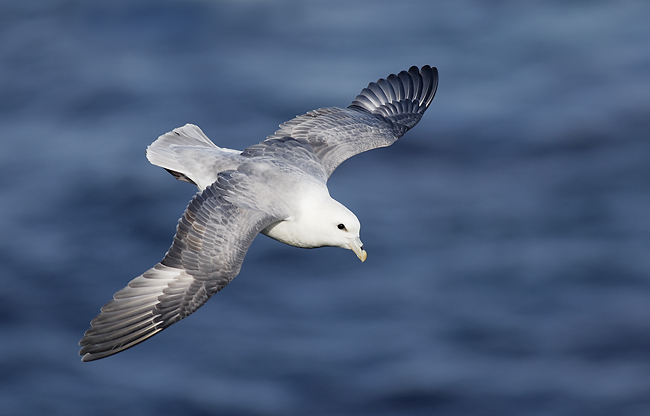
Northern Fulmar, dorsal view in flight, Iceland
Image Copyright 2007: Arthur Morris/BIRDS AS ART
Canon 400mm f/5.6L lens (handheld) with the EOS-1D Mark III. ISO 400. Evaluative metering -1/3 stop: 1/1250 sec. at f/5.6 in Manual mode.
I had only a single good chance to make an image like this and was thrilled with the results.
ICELAND TRIP REPORT
Seven others and I had a fantastic time in Iceland. The complete trip report will appear in a Bulletin before I leave for the Galapagos.
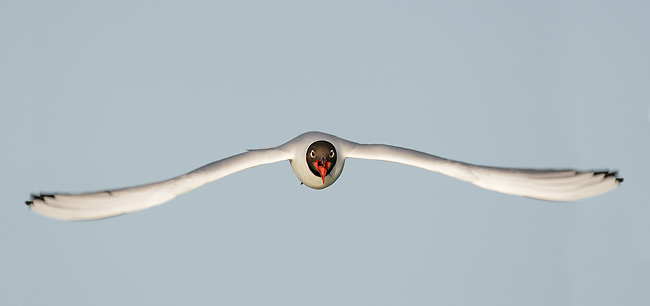
Black-headed Gull incoming flight, Iceland
Image Copyright 2007: Arthur Morris/BIRDS AS ART
Canon 500mm f/4L IS lens with the 1.4X II TC and the EOS-1D Mark III. ISO 400. Exposure verified with histogram check: 1/1000 sec. at f/7.1 in Manual mode.
Working in Manual mode whenever the background tonality may change quickly is highly recommended. This image was made 32 minutes after the first image in this Bulletin in the same light.
MARK III USER’S GUIDE
It is still my belief that the MIII is the best ever digital camera body for those photographing nature, birds in flight or in action, wildlife in action, and (possibly???) sports. It is, however, the most complex digital camera ever released. There are nine menu tabs that cover approximately 40 items (not including 57 Custom Functions in four groups!) Since the camera is quite complex and many of the basic camera operations are very different from previous Canon digital cameras, we will be offering the Mark III User’s Guide (MIII UG) PDF ($20 via e-mail only).
The UG will include instructions on how to set and use all of the menu items and custom functions that I am currently using, and best of all, your purchase will include at least one (but probably more) free updates (as I learn more about the camera). In addition, the UG will include basic directions for using Digital Photo Professional (DPP), the packaged RAW processor software that comes (on CD) with the MIII. As above, The Mark III User’s Guide update will be finished in about a week. It will include additional details on the AF issues discussed above, changes in the C. Fn. settings that I am now using, and an all-new section on AF Micro-adjustments. There will also be a quick-reference chart specifying my C. Fn. settings and additional comments on when and when not to use C. Fn. III-5-1.
You can order your copy of the Mark III User’s Guide PDF right now for $20—by e-mail only. As is usual Paypal is quite convenient. You can call us at 863-692-0906 with credit card in hand, or send a check for the correct amount made out to “Arthur Morris” to us as follows: Arthur Morris/BIRDS AS ART, PO Box 7245, 4041 Granada Drive, Indian Lake Estates, FL 33855.
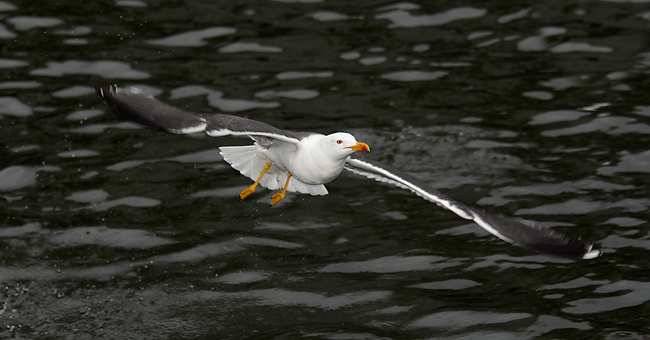
Lesser Black-backed Gull, adult taking flight, Iceland
Image Copyright 2007: Arthur Morris/BIRDS AS ART
Canon 70-200mm f/4L IS lens with the 1.4X II TC (handheld at 168mm) and the EOS-1D Mark III. ISO 800. Evaluative metering -1 stop: 1/800 sec. at f/5.6 in Manual mode. Fill flash at -1 stop.
Thanks to Jim Heupel for tossing some bread at t his bird which had been resting on the water. Here with just a bit of white in the frame and the black water, I needed lots of underexposure. To learn everything that you need to know about getting the right exposure, check out Exposure Simplified” in “The Art of Bird Photography II” (on CD only): http://www.birdsasart.com/ABPII.htm
BreezeBrowser Pro 1.7 AVAILABLE
The latest release of the outstandingly fast image browsing and raw conversion software BreezeBrowser Pro 1.7 is announced by Breeze Systems, creators of Windows-based software for digital photographers since 2001.
Features include:
· Canon EOS-1D Mark III Raw conversion
· Full support for Windows Vista
· Linking photographs and online galleries to online maps
(Show Focus Points, Show Flashing Highlights, and C. Fn. settings will be available in the next update which should be coming soon.)
The conversions of Mark III images are superb. You can order your copy of Breezebrowser (the package with Downloader Pro is highly recommended) here: http://www.birdsasart.com/breezebrowser.htm
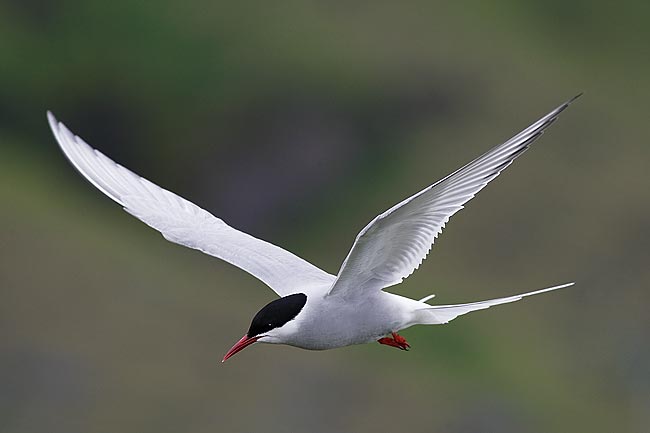
Arctic Tern, Iceland
Image Copyright 2007: Arthur Morris/BIRDS AS ART
Canon 400mm f/5.6L lens (handheld) with the EOS-1D Mark III. ISO 800. Evaluative metering +1 2/3 stops of white sky: 1/1600 sec. at f/6.3.
While at times we have the sensor right on the bird’s eye and the resulting image is soft, there are many cases (like the one above, no crop) where the sensor is clearly not on the bird yet the resulting image is sharp on the eye… Predictive autofocus is anything but predictable!
APATATS-1
The response to Robert O’Toole’s Advanced Photoshop Tips and Techniques Simplified-1 (APTATS-1) PDF (available only on CD) has been overwhelmingly positive.
Robert’s Quick Mask techniques will let you work faster and more efficiently. If you regularly use either the Clone tool or the Patch tool, learning to use Quick Masks instead will totally change the way you do things and approach difficult problems. The five topics covered clearly and concisely in APTATS-1 are:
1: Quick Mask Object Removal
2: Eye realignment and Repair
3: Restoring Highlight Detail
4: Clipped Feather Tip Repair
5: Clipped Wing Repair (with Exposure Adjustment)
With a bit of practice, using the techniques will become second nature. The great beauty of using Quick Masks is that once you learn the basics, you will find yourself using them for many tasks that are not specifically covered in the PDF. The sky really is the limit with Quick Masks.
You can order
your APTATS-1 PDF (on CD only today for $20 plus $3 shipping and handling ($23
total) in the
As usual, Paypal
is quite convenient. Be sure to include your ship-to address. You can call us
at 863-692-0906 with credit card in hand, or send a check for the correct amount
made out to “Arthur Morris” to us as follows: Arthur Morris/
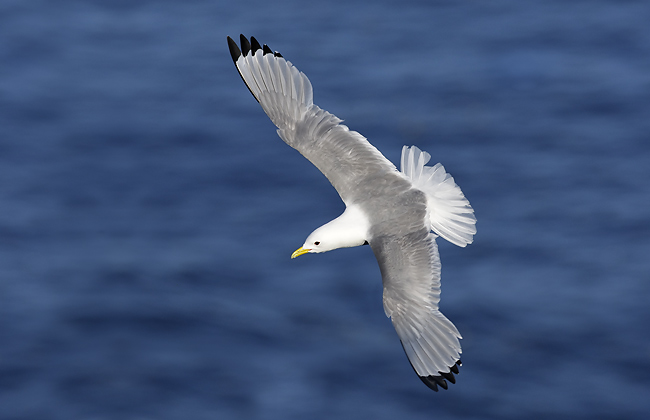
Black-legged Kittiwake, Iceland
Image Copyright 2007: Arthur Morris/BIRDS AS ART
Canon 400mm f/5.6L lens (handheld) with the EOS-1D Mark III. ISO 400. Evaluative metering -2/3 stop: 1/2000 sec. at f/7.1 in Manual mode.
I cut a good few inches off the bird’s near- wing in the image above. Using Robert O’Toole’s Quick Mask techniques I expanded the canvas and grabbed the portion of the wing that I needed from the next image in the sequence. The bird in each original photograph was razor sharp on the eye.
The image above was created from the two images below (with the top image being the main one). Quick mask techniques made it a three minute job.


How did I do Robert?
NYC SEMINAR NEWS
Registration has been picking up over the past few weeks; we now have 86 folks signed up with lots of out-of-towners. Nature photographers from Texas, Maryland, Virginia, Pennsylvania, Georgia, Massachusetts, Iowa, Maine, California, South Dakota, Quebec, Canada and the UK joining will be joining the many from the Tri-State area. Whenever I am within a three hour drive of a workshop given by a colleague I make it a point to attend. Folks are often curious as to why… No secret there: I want to learn more. Do consider joining us this August.
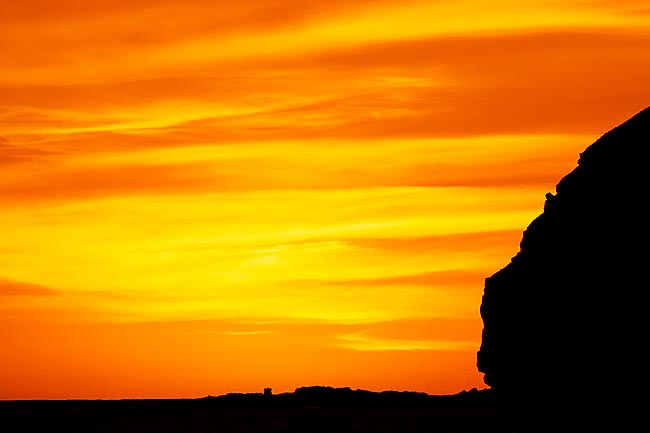
Cliff at sunset, Iceland
Image Copyright 2007: Arthur Morris/BIRDS AS ART
Canon 500mm f/4L IS lens with 1.4X II TC with the EOS-1D Mark III. ISO 200. Evaluative metering at zero: 1/800 sec. at f/8.
This image was made just a moment after the sun dipped briefly below the horizon at about 12:40 am on June 26th. Always remember: It ain’t just birds!
BAA KUDOS
Via e-mail from David Fletcher:
Hi Artie, I just wanted to say many thanks for the Mark III User’s Guide which has saved me long hours of fiddling around with the camera while configuring it to my taste. Thanks also for Robert O’Toole’s APATATS PDF. Despite being a Mac user, it is really easy to follow and has been a boon. (And it's taken years off the learning curve too). Cheers, Dave
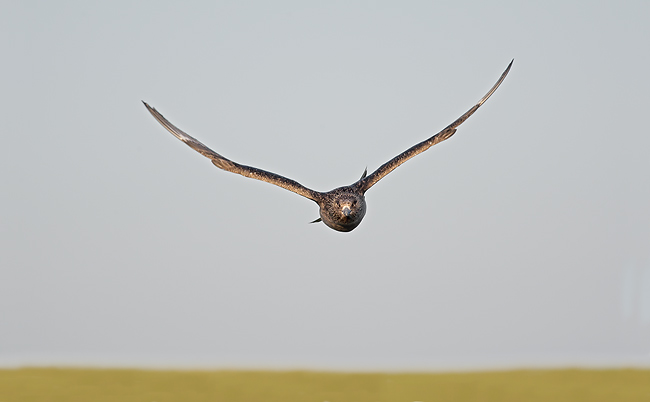
Great Skua, Iceland
Image Copyright 2007: Arthur Morris/BIRDS AS ART
Canon 400mm f/5.6L lens (handheld) with the EOS-1D Mark III. ISO 500. Evaluative metering +1 stop: 1/1000 sec. at f/5.6 in Manual mode.
I was able to track incoming birds better with the MIII than with any previous body…
IPT UPDATES
The third Bosque IPT has been sold our for some time and #1 and #2 are filling quite nicely. Acclaimed UK photographer Andy Rouse (who has had multiple images honored in the BBC Wildlife Photographer of the Year Competitions) will be joining me as a guest co-leader on the last day of Bosque #1 and for all of Bosque #2.
Bosque #1: "The Fall Color IPT" NOV 13-15, 2007. Slide Program on the evening of NOV 12. 3-DAY: $999. (Limit 14; openings: 5). Co-leader: Robert O'Toole. Guest leader (DAY 3 only): Andy Rouse. This IPT should feature a better chance for a day or two of the rare south winds that drastically improve flight photography and will definitely feature the brightest fall-color cottonwoods.
Bosque #2: "The Pre-Thanksgiving IPT" NOV 18-20, 2007. Slide Program on the evening of NOV 17. 3-DAY: $999. (Limit 14; openings: 3). Co-leader: Robert O'Toole & Alfred Forns. Guest leader: Andy Rouse. This IPT will feature increasing numbers of geese and cranes with lots of great opportunities. In 2007, I will again be hosting a Thanksgiving Day luncheon at Las Lunas Mansion, a fine restaurant in an historic building. You will need to reserve a spot and pay in advance. Details TBA; strictly limited to 50 folks.
Bosque #3: "The Post-Thanksgiving IPT" NOV 24-26, 2007. Slide Program on the evening of NOV 23. 3-DAY: $999. (Limit 14: Sold Out) Assistant leaders: Robert O'Toole, Robert Amoruso, and Alfred Forns. This IPT is scheduled on dates that I consider peak for Bosque. (There may be a Full Moon Add-on NOV 23; details TBA.) If you register for this one, hold off on buying your plane ticket if you might be interested in the add-on.) In 2007, I will again be hosting a Thanksgiving Day luncheon at Las Lunas Mansion, a fine restaurant in an historic building. You will need to reserve a spot and pay in advance. Details TBA; strictly limited to 50 folks.
SW FLA Post X-mas IPT: DEC 27-29, 2007). Slide program on the evening Wednesday, DEC 26, 2006. 3-DAY: $1029. (Limit 12) Co-leaders: Alfred Forns, & Robert O'Toole. Sanibel Island, Venice Rookery, Cape Coral, and possibly Little Estero Lagoon (depending on the tides). Herons, egrets, gulls, terns, skimmers, shorebirds, both pelicans, Osprey, Burrowing Owl, and lots more. Roseate Spoonbill and Wood Stork possible.
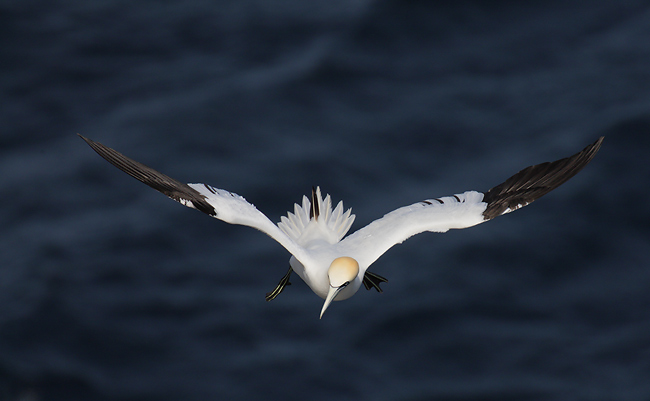
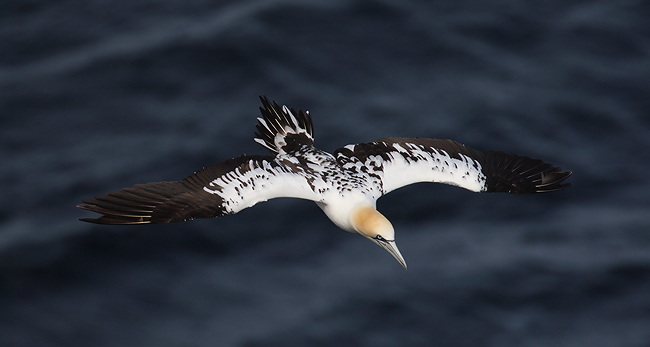
Northern Gannet, adult above, immature below, Iceland
Image Copyright 2007: Arthur Morris/BIRDS AS ART
Canon 500mm f/4L IS lens with the 2X II TC and the EOS-1D Mark III. ISO 400. Evaluative metering -1 stop: 1/1600 sec. at f/8 in Manual mode.
Because each bird had some bright white on it, exposure was identical. I was surprisingly pleased with the flight images created with the MIII and the 2X TC on the 500.
Best and love and great picture-making to all,
artie
Note: Arthur Morris has been a Canon contract photographer since 1994 and continues in that role today. Hunt's Photo of Boston, MA is a BAA sponsor as it Delkin Devices. Back issues of all BAA Bulletins can be found in the Bulletin Archives which may be accessed from the home page at www.birdsasart.com